fuel consumption MERCEDES-BENZ ML SUV 2008 Owners Manual
[x] Cancel search | Manufacturer: MERCEDES-BENZ, Model Year: 2008, Model line: ML SUV, Model: MERCEDES-BENZ ML SUV 2008Pages: 381, PDF Size: 7.18 MB
Page 10 of 381
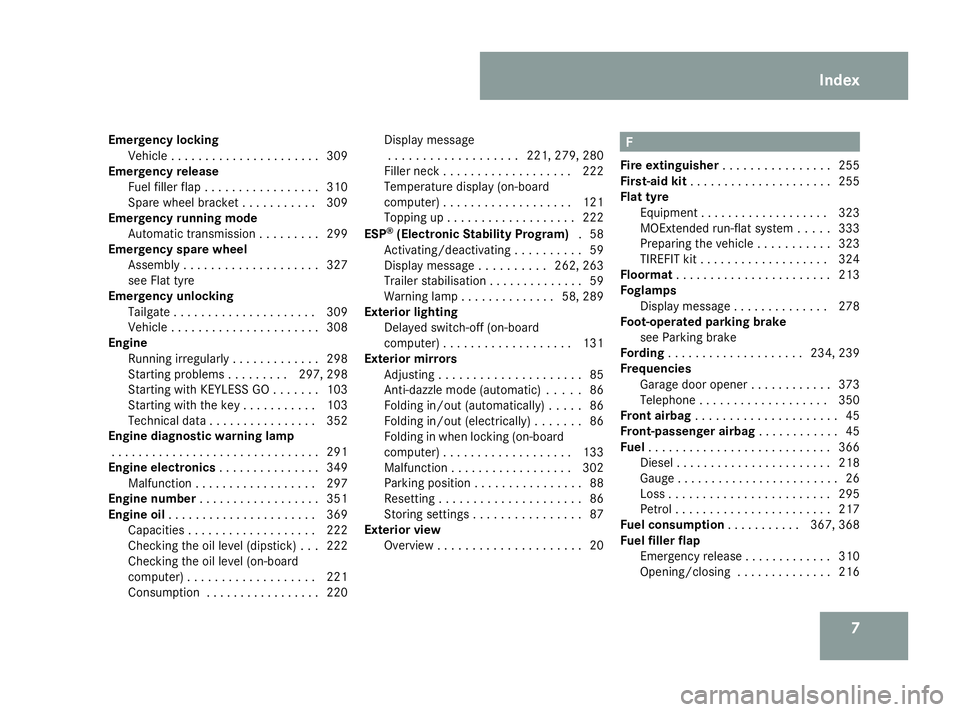
7
Emergency locking
Vehicle . . . . . . . . . . . . . . . . . . . . . .309
Emergency release
Fuel filler fla p.. . . . . . . . . . . . . . . .310
Spare wheel bracket . . . . . . . . . . .309
Emergency running mode
Automatic transmission . . . . . . . . .299
Emergency spare wheel
Assembl y.. . . . . . . . . . . . . . . . . . .327
see Flat tyre
Emergency unlocking
Tailgate . . . . . . . . . . . . . . . . . . . . .309
Vehicle . . . . . . . . . . . . . . . . . . . . . .308
Engine
Running irregularl y.. . . . . . . . . . . .298
Starting problems . . . . . . . . .297, 298
Starting with KEYLESS GO . . . . . . .103
Starting with the key . . . . . . . . . . .103
Technical data . . . . . . . . . . . . . . . .352
Engine diagnostic warning lamp
. . . . . . . . . . . . . . . . . . . . . . . . . . . . . . .291
Engine electronics . . . . . . . . . . . . . ..349
Malfunction . . . . . . . . . . . . . . . . . .297
Engine number . . . . . . . . . . . . . . . . . .351
Engine oil . . . . . . . . . . . . . . . . . . . . . .369
Capacities . . . . . . . . . . . . . . . . . . .222
Checking the oil level (dipstick) . . .222
Checking the oil level (on-board
computer) . . . . . . . . . . . . . . . . . . .221
Consumption . . . . . . . . . . . . . . . . .220 Display message
. . . . . . . . . . . . . . . . . . .221, 279, 280
Filler neck . . . . . . . . . . . . . . . . . . .222
Temperature display (on-board
computer) . . . . . . . . . . . . . . . . . . .121
Topping up . . . . . . . . . . . . . . . . . . .222
ESP ®
(Electronic Stability Program) .58
Activating/deactivating . . . . . . . . . .59
Display message . . . . . . . . . .262, 263
Trailer stabilisatio n.. . . . . . . . . . . . .59
Warning lamp . . . . . . . . . . . . . .58, 289
Exterior lighting
Delayed switch-off (on-board
computer) . . . . . . . . . . . . . . . . . . .131
Exterior mirrors
Adjusting . . . . . . . . . . . . . . . . . . . . .85
Anti-dazzle mode (automatic) . . . . .86
Folding in/out (automatically ).. . . .86
Folding in/out (electrically) . . . . . . .86
Folding in when locking (on-board
computer) . . . . . . . . . . . . . . . . . . .133
Malfunction . . . . . . . . . . . . . . . . . .302
Parking position . . . . . . . . . . . . . . . .88
Resettin g.. . . . . . . . . . . . . . . . . . . .86
Storing settings . . . . . . . . . . . . . . . .87
Exterior view
Overview . . . . . . . . . . . . . . . . . . . . .20 F
Fire extinguisher . . . . . . . . . . . . . . . .255
First-aid kit . . . . . . . . . . . . . . . . . . . . .255
Flat tyre Equipment . . . . . . . . . . . . . . . . . . .323
MOExtended run-flat system . . . . .333
Preparing the vehicle . . . . . . . . . . .323
TIREFIT kit . . . . . . . . . . . . . . . . . . .324
Floormat . . . . . . . . . . . . . . . . . . . . . . .213
Foglamps Display message . . . . . . . . . . . . . .278
Foot-operated parking brake
see Parking brake
Fording . . . . . . . . . . . . . . . . . . . .234, 239
Frequencies Garage door opener . . . . . . . . . . . .373
Telephone . . . . . . . . . . . . . . . . . . .350
Front airbag . . . . . . . . . . . . . . . . . . . . .45
Front-passenger airbag . . . . . . . . . . ..45
Fuel . . . . . . . . . . . . . . . . . . . . . . . . . . .366
Diese l.. . . . . . . . . . . . . . . . . . . . . .218
Gauge . . . . . . . . . . . . . . . . . . . . . . . .26
Loss . . . . . . . . . . . . . . . . . . . . . . . .295
Petrol . . . . . . . . . . . . . . . . . . . . . . .217
Fuel consumption . . . . . . . . . ..367, 368
Fuel filler flap Emergency release . . . . . . . . . . . . .310
Opening/closing . . . . . . . . . . . . . .216 Index
164_AKB; 5; 5, en-GB
wobuchh,
Version: 2.10.6 2008-05-11T11:55:12+02:00 - Seite 7Dateiname: 6515_4293_02_buchblock.pdf; preflight
Page 19 of 381
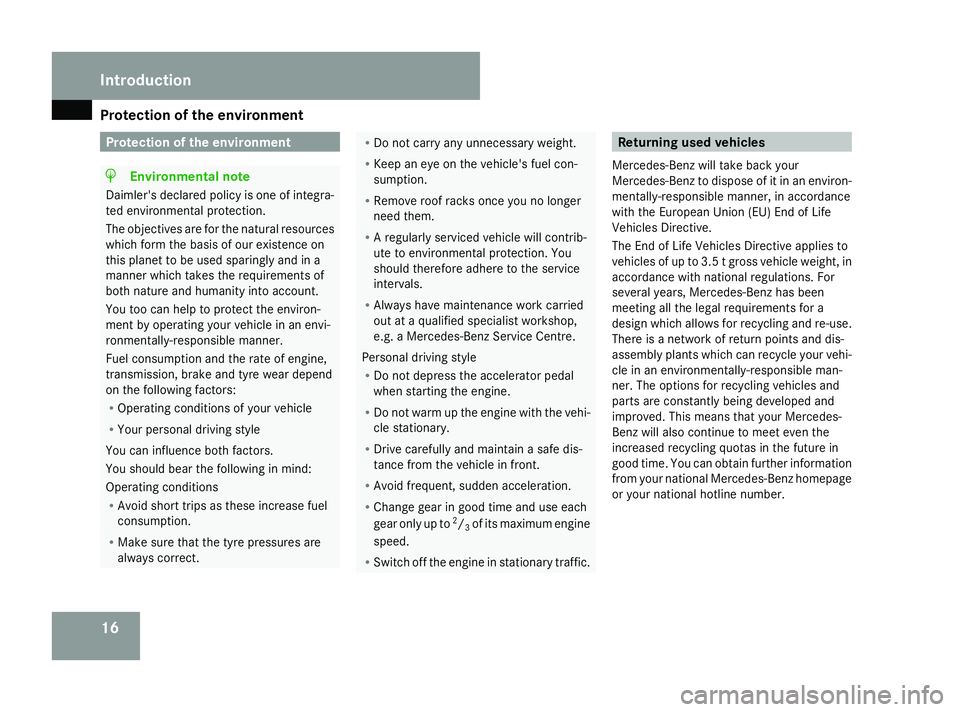
Protection of the environment
16 Protection of the environment
H
Environmental note
Daimler's declared policy is one of integra-
ted environmental protection.
The objectives are for the natural resources
which form the basis of our existence on
this planet to be used sparingly and in a
manner which takes the requirements of
both nature and humanity into account.
You too can help to protect the environ-
ment by operating your vehicle in an envi-
ronmentally-responsible manner.
Fuel consumption and the rate of engine,
transmission, brake and tyre wear depend
on the following factors:
R Operating conditions of your vehicle
R Your personal driving style
You can influence both factors.
You should bear the following in mind:
Operating conditions
R Avoid short trips as these increase fuel
consumption.
R Make sure that the tyre pressures are
always correct. R
Do not carry any unnecessary weight.
R Keep an eye on the vehicle's fuel con-
sumption.
R Remove roof racks once you no longer
need them.
R A regularly serviced vehicle will contrib-
ute to environmental protection. You
should therefore adhere to the service
intervals.
R Always have maintenance work carried
out at a qualified specialist workshop,
e.g. a Mercedes-Benz Service Centre.
Personal driving style
R Do not depress the accelerator pedal
when starting the engine.
R Do not warm up the engine with the vehi-
cle stationary.
R Drive carefully and maintain a safe dis-
tance from the vehicle in front.
R Avoid frequent, sudden acceleration.
R Change gear in good time and use each
gear only up to 2
/ 3of its maximum engine
speed.
R Switch off the engine in stationary traffic. Returning used vehicles
Mercedes-Benz will take back your
Mercedes-Benz to dispose of it in an environ-
mentally-responsible manner, in accordance
with the European Union (EU) End of Life
Vehicles Directive.
The End of Life Vehicles Directive applies to
vehicles of up to 3.5 t gross vehicle weight, in
accordance with national regulations. For
several years, Mercedes-Benz has been
meeting all the legal requirements for a
design which allows for recycling and re-use.
There is a network of return points and dis-
assembly plants which can recycle your vehi-
cle in an environmentally-responsible man-
ner. The options for recycling vehicles and
parts are constantly being developed and
improved. This means that your Mercedes-
Benz will also continue to meet even the
increased recycling quotas in the future in
good time. You can obtain further information
from your national Mercedes-Benz homepage
or your national hotline number. Introduction
164_AKB; 5; 5, en-GB
wobuchh,
Version: 2.10.6 2008-05-11T11:55:12+02:00 - Seite 16Dateiname: 6515_4293_02_buchblock.pdf; preflight
Page 117 of 381
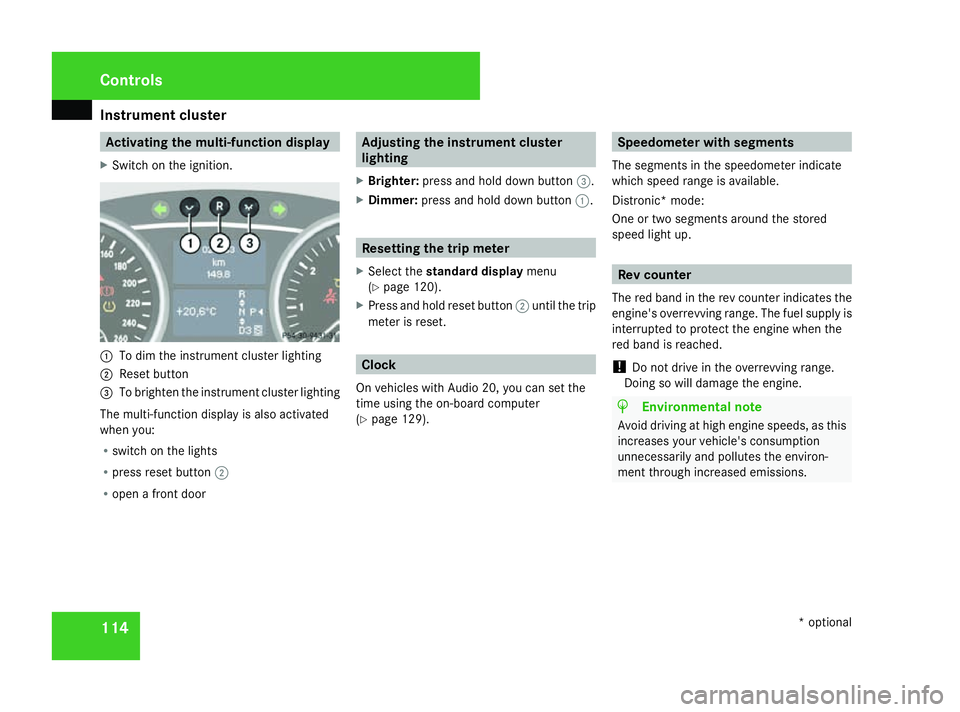
Instrument cluster
114 Activating the multi-function display
X Switch on the ignition. 1
To dim the instrument cluster lighting
2 Reset button
3 To brighten the instrument cluster lighting
The multi-function display is also activated
when you:
R switch on the lights
R press reset button 2
R open a front door Adjusting the instrument cluster
lighting
X Brighter: press and hold down button 3.
X Dimmer: press and hold down button 1. Resetting the trip meter
X Select the standard display menu
(Y page 120).
X Press and hold reset button 2until the trip
meter is reset. Clock
On vehicles with Audio 20, you can set the
time using the on-board computer
(Y page 129). Speedometer with segments
The segments in the speedometer indicate
which speed range is available.
Distronic* mode:
One or two segments around the stored
speed light up. Rev counter
The red band in the rev counter indicates the
engine's overrevving range. The fuel supply is
interrupted to protect the engine when the
red band is reached.
! Do not drive in the overrevving range.
Doing so will damage the engine. H
Environmental note
Avoid driving at high engine speeds, as this
increases your vehicle's consumption
unnecessarily and pollutes the environ-
ment through increased emissions. Cont
rols
* optional
164_AKB; 5; 5, en-GB
wobuchh
,V ersion: 2.10.6
2008-05-11T11:55:12+02:00 - Seite 114 Dateiname: 6515_4293_02_buchblock.pdf; preflight
Page 138 of 381

On-board computer
135
between 4 km/h and 18 km/h. The adjust-
ment is carried out in increments of 2 km/h.
X
Press the èor· button to select the
Additional functions menu.
X If the DSR Speed function is not displayed,
press the jork button to select the
DSR.
X Press the æorç button to set the
desired threshold speed.
X Press the j,èorÿ button to
select a different display.
Priming/deactivating tow-away protec-
tion* If you deactivate
Tow-away protection, it
will not be primed when you next lock the
vehicle.
X Press the èor· button to select the
Additional functions menu.
X IfTow-away protection is not displayed,
press the jork button to select
Tow-away protection.
X Press the æorç button to prime or
deactivate Tow-away protection.
X Press the j,èorÿ button to
select a different display. Priming/deactivating the interior
motion sensor* If you deactivate the
Interior motion sen-
sor, it will not be primed when you next lock
the vehicle.
X Press the èor· button to select the
Additional functions menu.
X If the Interior motion sensor function
is not displayed, press the jork
button to select the Interior motion
sensor.
X Press the æorç button to prime or
deactivate the Interior motion sen-
sor.
X Press the j,èorÿ button to
select a different display. Trip computer menu
You can use the Trip computermenu to call
up or reset statistical data for your vehicle.
i You can select kmormiles as the unit of
measurement for distance (Y page 128).
i Menu overview: (Y page 118).
Use the buttons on the multi-function steer-
ing wheel.
Consumption statistics from start The values refer to the start of the journey.
X
Press the èor· button to select
From start. 1
Kilometres
2 Time
3 Average speed
4 Average fuel consumption Controls
* optional
164_AKB; 5; 5, en-GB
wobuchh,
Version: 2.10.6 2008-05-11T11:55:12+02:00 - Seite 135 ZDateiname: 6515_4293_02_buchblock.pdf; preflight
Page 139 of 381
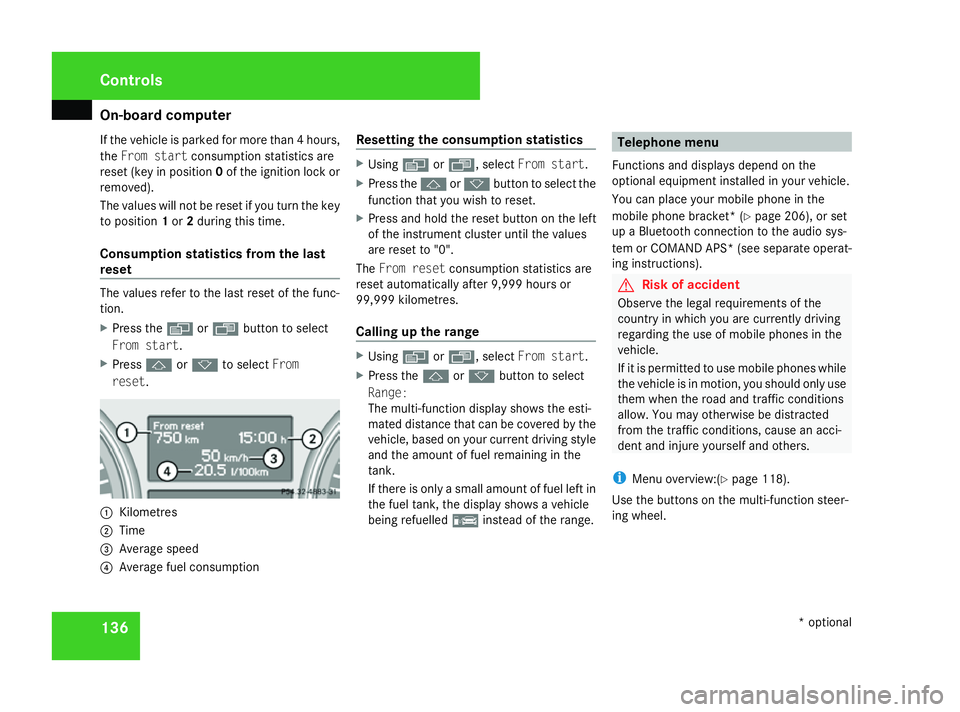
On-board computer
136
If the vehicle is parked for more than 4 hours,
the From start consumption statistics are
reset (key in position 0of the ignition lock or
removed).
The values will not be reset if you turn the key
to position 1or 2during this time.
Consumption statistics from the last
reset The values refer to the last reset of the func-
tion.
X Press the èor· button to select
From start.
X Press jork to select From
reset. 1
Kilometres
2 Time
3 Average speed
4 Average fuel consumption Resetting the consumption statistics X
Using èor·, select From start.
X Press the jork button to select the
function that you wish to reset.
X Press and hold the reset button on the left
of the instrument cluster until the values
are reset to "0".
The From reset consumption statistics are
reset automatically after 9,999 hours or
99,999 kilometres.
Calling up the range X
Using èor·, select From start.
X Press the jork button to select
Range:
The multi-function display shows the esti-
mated distance that can be covered by the
vehicle, based on your current driving style
and the amount of fuel remaining in the
tank.
If there is only a small amount of fuel left in
the fuel tank, the display shows a vehicle
being refuelled ¿instead of the range. Telephone menu
Functions and displays depend on the
optional equipment installed in your vehicle.
You can place your mobile phone in the
mobile phone bracket* (Y page 206), or set
up a Bluetooth connection to the audio sys-
tem or COMAND APS *(see separate operat-
ing instructions). G
Risk of accident
Observe the legal requirements of the
country in which you are currently driving
regarding the use of mobile phones in the
vehicle.
If it is permitted to use mobile phones while
the vehicle is in motion, you should only use
them when the road and traffic conditions
allow. You may otherwise be distracted
from the traffic conditions, cause an acci-
dent and injure yourself and others.
i Menu overview:(Y page 118).
Use the buttons on the multi-function steer-
ing wheel. Controls
* optional
164_AKB; 5; 5, en-GB
wobuchh,
Version: 2.10.6 2008-05-11T11:55:12+02:00 - Seite 136Dateiname: 6515_4293_02_buchblock.pdf; preflight
Page 161 of 381
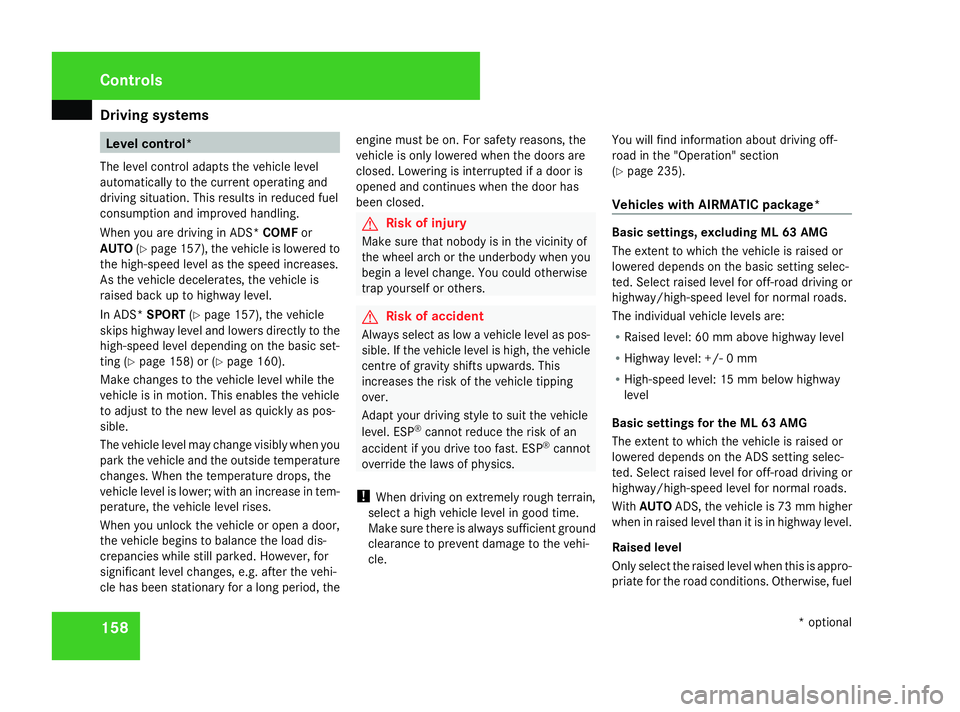
Driving sys
tems 158 Level control*
The level control adapts the vehicle level
automatically to the current operating and
driving situation. This results in reduced fuel
consumption and improved handling.
When you are driving in ADS* COMFor
AUTO (Ypage 157), the vehicle is lowered to
the high-speed level as the speed increases.
As the vehicle decelerates, the vehicle is
raised back up to highway level.
In ADS* SPORT(Ypage 157), the vehicle
skips highway level and lowers directly to the
high-speed level depending on the basic set-
ting (Y page 158) or (Y page 160).
Make changes to the vehicle level while the
vehicle is in motion. This enables the vehicle
to adjust to the new level as quickly as pos-
sible.
The vehicle level may change visibly when you
park the vehicle and the outside temperature
changes. When the temperature drops, the
vehicle level is lower; with an increase in tem-
perature, the vehicle level rises.
When you unlock the vehicle or open a door,
the vehicle begins to balance the load dis-
crepancies while still parked. However, for
significant level changes, e.g. after the vehi-
cle has been stationary for a long period, the engine must be on. For safety reasons, the
vehicle is only lowered when the doors are
closed. Lowering is interrupted if a door is
opened and continues when the door has
been closed. G
Risk of injury
Make sure that nobody is in the vicinity of
the wheel arch or the underbody when you
begin a level change. You could otherwise
trap yourself or others. G
Risk of accident
Always select as low a vehicle level as pos-
sible. If the vehicle level is high, the vehicle
centre of gravity shifts upwards. This
increases the risk of the vehicle tipping
over.
Adapt your driving style to suit the vehicle
level. ESP ®
cannot reduce the risk of an
accident if you drive too fast. ESP ®
cannot
override the laws of physics.
! When driving on extremely rough terrain,
select a high vehicle level in good time.
Make sure there is always sufficient ground
clearance to prevent damage to the vehi-
cle. You will find information about driving off-
road in the "Operation" section
(Y
page 235).
Vehicles with AIRMATIC package* Basic settings, excluding ML 63 AMG
The extent to which the vehicle is raised or
lowered depends on the basic setting selec-
ted. Select raised level for off-road driving or
highway/high-speed level for normal roads.
The individual vehicle levels are:
R
Raised level: 60 mm above highway level
R Highway level: +/- 0 mm
R High-speed level: 15 mm below highway
level
Basic settings for the ML 63 AMG
The extent to which the vehicle is raised or
lowered depends on the ADS setting selec-
ted. Select raised level for off-road driving or
highway/high-speed level for normal roads.
With AUTO ADS, the vehicle is 73 mm higher
when in raised level than it is in highway level.
Raised level
Only select the raised level when this is appro-
priate for the road conditions. Otherwise, fuel Controls
* optional
164_AKB; 5; 5, en-GB
wobuchh
,V ersion: 2.10.6
2008-05-11T11:55:12+02:00 - Seite 158 Dateiname: 6515_4293_02_buchblock.pdf; preflight
Page 164 of 381

Driving sys
tems 161R
Avoid sudden major steering move-
ments.
R Take account of the altered handling
characteristics.
If you are driving too fast in off-road level 3,
the Bring speed below 20 km/h message
appears in the multi-function display. You
additionally hear a warning tone. The vehicle
is lowered.
i You cannot clear these messages.
Only select an off-road level when this is
appropriate for the road conditions. Other-
wise, fuel consumption increases and han-
dling performance may be affected.
Your selection remains stored even if you
remove the key from the ignition lock. 1
To raise the level
2 To lower the level
3 Indicator lamps
X Start the engine.
X Turn selector wheel 1clockwise.
The vehicle is raised.
or
X Turn selector wheel 2anti-clockwise.
The vehicle is lowered. Indicator lamps
3for the desired off-road
level flash:
R Off-road level 1: the lower indicator lamp
flashes
R Off-road level 2: the lower and centre indi-
cator lamps flash
R Off-road level 3: all three indicator lamps
flash
The vehicle is being adjusted to the off-road
level selected. As soon as an off-road level is
reached, the corresponding indicator lamp
stops flashing and lights up constantly.
While the adjustment is taking place, a mes-
sage appears in the multi-function display,
e.g. : The vehicle rises from highway level to off-
road level 1.
If you press the
æorç button on the
multi-function steering wheel, the messages
will disappear. Controls
164_AKB; 5; 5, en-GB
wobuchh
,V ersion: 2.10.6
2008-05-11T11:55:12+02:00 - Seite 161 ZDateiname: 6515_4293_02_buchblock.pdf; preflight
Page 221 of 381
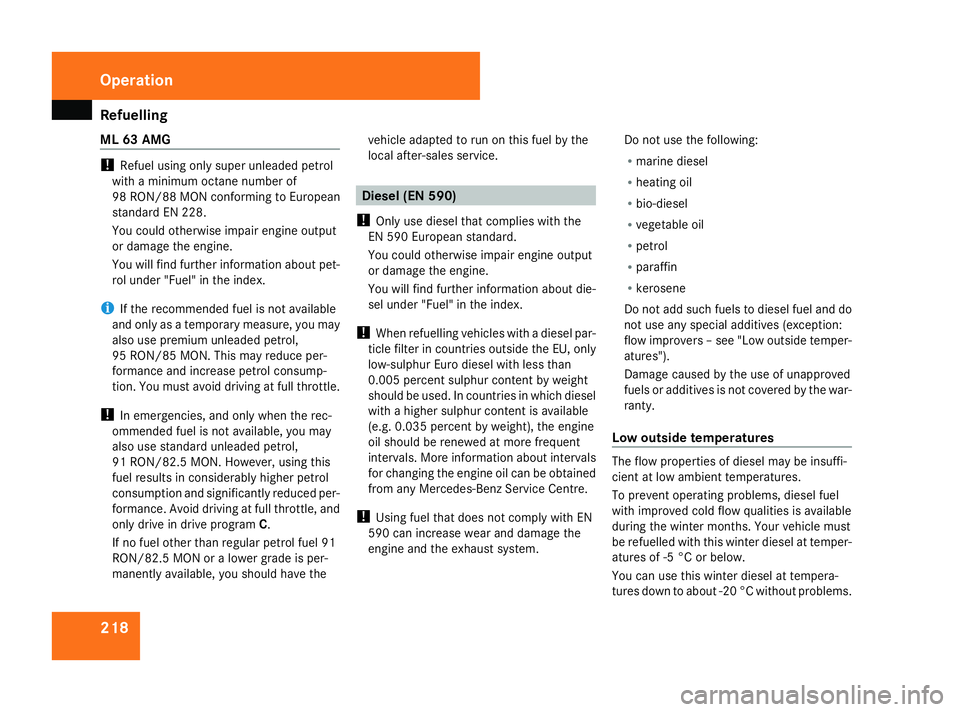
Refuelling
218
ML 63 AMG !
Refuel using only super unleaded petrol
with a minimum octane number of
98 RON/88 MON conforming to European
standard EN 228.
You could otherwise impair engine output
or damage the engine.
You will find further information about pet-
rol under "Fuel" in the index.
i If the recommended fuel is not available
and only as a temporary measure, you may
also use premium unleaded petrol,
95 RON/85 MON. This may reduce per-
formance and increase petrol consump-
tion. You must avoid driving at full throttle.
! In emergencies, and only when the rec-
ommended fuel is not available, you may
also use standard unleaded petrol,
91 RON/82.5 MON. However, using this
fuel results in considerably higher petrol
consumption and significantly reduced per-
formance. Avoid driving at full throttle, and
only drive in drive program C.
If no fuel other than regular petrol fuel 91
RON/82.5 MON or a lower grade is per-
manently available, you should have the vehicle adapted to run on this fuel by the
local after-sales service. Diesel (EN 590)
! Only use diesel that complies with the
EN 590 European standard.
You could otherwise impair engine output
or damage the engine.
You will find further information about die-
sel under "Fuel" in the index.
! When refuelling vehicles with a diesel par-
ticle filter in countries outside the EU, only
low-sulphur Euro diesel with less than
0.005 percent sulphur content by weight
should be used. In countries in which diesel
with a higher sulphur content is available
(e.g. 0.035 percent by weight), the engine
oil should be renewed at more frequent
intervals. More information about intervals
for changing the engine oil can be obtained
from any Mercedes-Benz Service Centre.
! Using fuel that does not comply with EN
590 can increase wear and damage the
engine and the exhaust system. Do not use the following:
R
marine diesel
R heating oil
R bio-diesel
R vegetable oil
R petrol
R paraffin
R kerosene
Do not add such fuels to diesel fuel and do
not use any special additives (exception:
flow improvers – see "Low outside temper-
atures").
Damage caused by the use of unapproved
fuels or additives is not covered by the war-
ranty.
Low outside temperatures The flow properties of diesel may be insuffi-
cient at low ambient temperatures.
To prevent operating problems, diesel fuel
with improved cold flow qualities is available
during the winter months. Your vehicle must
be refuelled with this winter diesel at temper-
atures of -5 °C or below.
You can use this winter diesel at tempera-
tures down to about -20 °C without problems.Operation
164_AKB; 5; 5, en-GB
wobuchh,
Version: 2.10.6 2008-05-11T11:55:12+02:00 - Seite 218Dateiname: 6515_4293_02_buchblock.pdf; preflight
Page 227 of 381
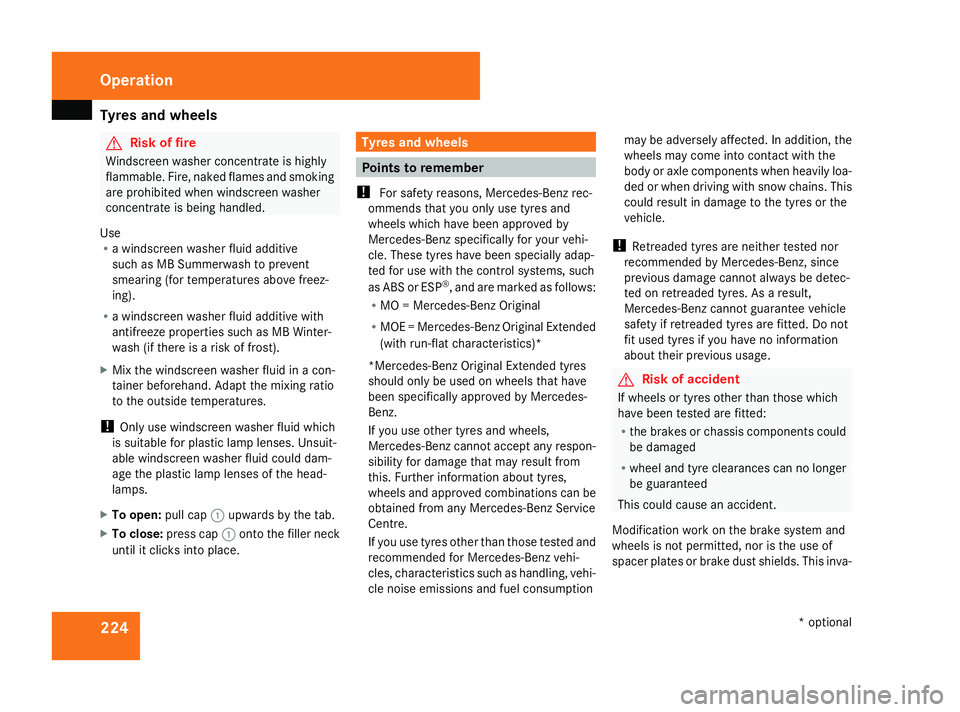
Tyres and wheels
224 G
Risk of fire
Windscreen washer concentrate is highly
flammable. Fire, naked flames and smoking
are prohibited when windscreen washer
concentrate is being handled.
Use
R a windscreen washer fluid additive
such as MB Summerwash to prevent
smearing (for temperatures above freez-
ing).
R a windscreen washer fluid additive with
antifreeze properties such as MB Winter-
wash (if there is a risk of frost).
X Mix the windscreen washer fluid in a con-
tainer beforehand. Adapt the mixing ratio
to the outside temperatures.
! Only use windscreen washer fluid which
is suitable for plastic lamp lenses. Unsuit-
able windscreen washer fluid could dam-
age the plastic lamp lenses of the head-
lamps.
X To open: pull cap1upwards by the tab.
X To close: press cap 1onto the filler neck
until it clicks into place. Tyres and wheels
Points to remember
! For safety reasons, Mercedes-Benz rec-
ommends that you only use tyres and
wheels which have been approved by
Mercedes-Benz specifically for your vehi-
cle. These tyres have been specially adap-
ted for use with the control systems, such
as ABS or ESP ®
, and are marked as follows:
R MO = Mercedes-Benz Original
R MOE = Mercedes-Benz Original Extended
(with run-flat characteristics)*
*Mercedes-Benz Original Extended tyres
should only be used on wheels that have
been specifically approved by Mercedes-
Benz.
If you use other tyres and wheels,
Mercedes-Benz cannot accept any respon-
sibility for damage that may result from
this. Further information about tyres,
wheels and approved combinations can be
obtained from any Mercedes-Benz Service
Centre.
If you use tyres other than those tested and
recommended for Mercedes-Benz vehi-
cles, characteristics such as handling, vehi-
cle noise emissions and fuel consumption may be adversely affected. In addition, the
wheels may come into contact with the
body or axle components when heavily loa-
ded or when driving with snow chains. This
could result in damage to the tyres or the
vehicle.
! Retreaded tyres are neither tested nor
recommended by Mercedes-Benz, since
previous damage cannot always be detec-
ted on retreaded tyres. As a result,
Mercedes-Benz cannot guarantee vehicle
safety if retreaded tyres are fitted. Do not
fit used tyres if you have no information
about their previous usage. G
Risk of accident
If wheels or tyres other than those which
have been tested are fitted:
R the brakes or chassis components could
be damaged
R wheel and tyre clearances can no longer
be guaranteed
This could cause an accident.
Modification work on the brake system and
wheels is not permitted, nor is the use of
spacer plates or brake dust shields. This inva- Operation
* optional
164_AKB; 5; 5, en-GB
wobuchh
,V ersion: 2.10.6
2008-05-11T11:55:12+02:00 - Seite 224 Dateiname: 6515_4293_02_buchblock.pdf; preflight
Page 357 of 381
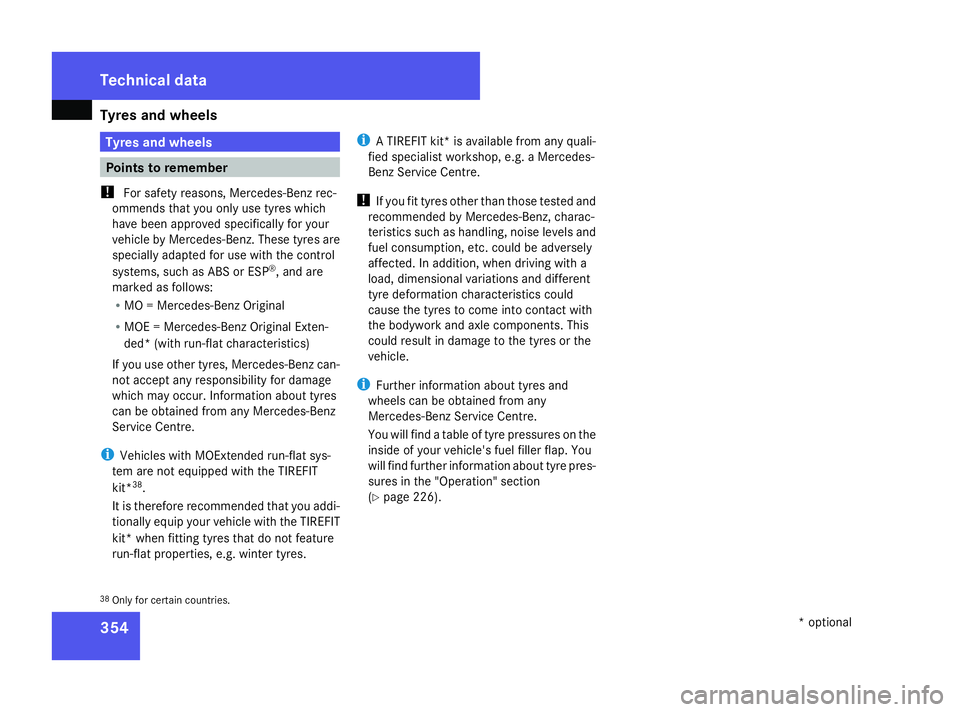
Tyres and wheels
354 Tyres and wheels
Points to remember
! For safety reasons, Mercedes-Benz rec-
ommends that you only use tyres which
have been approved specifically for your
vehicle by Mercedes-Benz. These tyres are
specially adapted for use with the control
systems, such as ABS or ESP ®
, and are
marked as follows:
R MO = Mercedes-Benz Original
R MOE = Mercedes-Benz Original Exten-
ded* (with run-flat characteristics)
If you use other tyres, Mercedes-Benz can-
not accept any responsibility for damage
which may occur. Information about tyres
can be obtained from any Mercedes-Benz
Service Centre.
i Vehicles with MOExtended run-flat sys-
tem are not equipped with the TIREFIT
kit* 38
.
It is therefore recommended that you addi-
tionally equip your vehicle with the TIREFIT
kit* when fitting tyres that do not feature
run-flat properties, e.g. winter tyres. i
A TIREFIT kit* is available from any quali-
fied specialist workshop, e.g. a Mercedes-
Benz Service Centre.
! If you fit tyres other than those tested and
recommended by Mercedes-Benz, charac-
teristics such as handling, noise levels and
fuel consumption, etc. could be adversely
affected. In addition, when driving with a
load, dimensional variations and different
tyre deformation characteristics could
cause the tyres to come into contact with
the bodywork and axle components. This
could result in damage to the tyres or the
vehicle.
i Further information about tyres and
wheels can be obtained from any
Mercedes-Benz Service Centre.
You will find a table of tyre pressures on the
inside of your vehicle's fuel filler flap. You
will find further information about tyre pres-
sures in the "Operation" section
(Y page 226).
38 Only for certain countries. Technical data
* optional
164_AKB; 5; 5, en-GB
wobuchh
,V ersion: 2.10.6
2008-05-11T11:55:12+02:00 - Seite 354 Dateiname: 6515_4293_02_buchblock.pdf; preflight